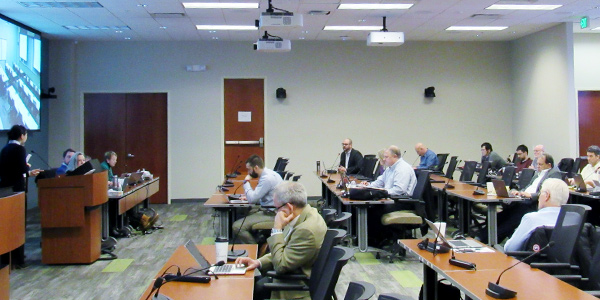By Amanda Durish Cook
CARMEL, Ind. — Staff engaged in MISO’s ongoing market system replacement will this year focus on moving the platform to the cloud and creating a single means of submitting modeling data, stakeholders learned last week.
MISO plans to move its system from a server-based platform to the cloud some time in 2020, IT Senior Director Curtis Reister said during a Jan. 17 Market Subcommittee meeting. The RTO will phase in use of the new system gradually from 2020 to 2024.
“We’re going to do what’s called a private cloud,” Reister said.
He explained that while the cloud platform will function like a public network to staff, equipment to support it will be built solely for MISO and be kept on RTO premises, keeping systems more secure.
The new platform will be designed to accommodate market changes more quickly, Reister said. “With a big monolithic system like today, it is difficult to find the impacts of even a modest change.”
By 2021, the cloud-based platform will also include a “model manager,” a single integrated system for model data submission and validation. MISO currently relies on several different means to collect and process grid information for modeling.
“The model data comes in through a lot of different sources. We’re looking at a much more seamless way to gather and verify that information,” Reister said.
Also by 2021, MISO will launch a new user interface for members to submit market transactions such as bids and offers.
MISO plans to update the current interface early this year to address browser incompatibility, behind the originally scheduled release in late 2018. Members have reported having to rely on old versions of web browsers to use the current interface.
Stakeholders asked for an update on current vendor General Electric’s overall performance on the early stages of the multilevel project.
“We’re currently on schedule with our deliveries with GE,” Reister said in response to stakeholder inquiries about the company’s performance. GE has steadily shown it has the resources and ability to meet the RTO’s demands, he added.
MISO continues to “monitor” news around GE and the company’s performance, Reister said. Last week, at least one financial analyst predicted that GE’s financial performance will begin to rebound.
The RTO has said it will not announce a recommended final platform vendor until the fourth quarter, when it finishes evaluating alternatives. (See “Market Platform Replacement Enters Year 3,” MISO Board of Directors Briefs: Dec. 6, 2018.)
MISO has committed to another stakeholder update of its platform replacement in April.
At Least 1 Market Project Delay
While MISO expects to continue carrying out improvements to its current platform, at least one market upgrade will be placed on hold until the new system is operational.
Implementation of more sophisticated modeling software that can accommodate different combinations of combined cycle units and their dependencies will be postponed until mid-2023, MISO said. The RTO originally planned to have the improvement in place by 2020 but last year announced a delay until 2022. (See MISO Delays Combined Cycle Model Update.)
MISO Executive Director of Market Operations Shawn McFarlane said there are “technical issues in installing it on the legacy system,” explaining that day-ahead market clearing could experience delays if the project were implemented in the current system.
Director of Market System Enhancement Dhiman Chatterjee said market systems would experience a “significant amount of uncertainty” if the RTO implemented combined cycle modeling on the existing platform.
However, MISO’s proposed, short-term reserve product, which will furnish capacity within 30 minutes, will still move ahead as planned, supported by the current market platform. The RTO hopes to roll out the new type of reserve in mid-2021.
MISO last week published a conceptual design of short-term operating reserves in which online and offline resources can either register as a supplier or provide availability through hourly offers in the day-ahead and real-time markets. Resources would clear according to opportunity costs, offer prices and a demand curve when insufficient amounts of the reserves exist. Clearing resources will be paid their respective zonal market clearing prices. The early design doesn’t account for participation by storage resources, but the RTO said later versions will include storage participation “where appropriate.”
MISO said 30-minute operational needs are “not efficiently modeled” in the current market, and that a new reserve product would help better manage its Midwest-South contractual limit on SPP’s transmission, manage constrained load pockets and meet systemwide energy needs even during times of load and supply volatility. The new reserve type would be especially helpful in MISO South, where operators rely on less transparent out-of-market commitments to address the Midwest-South transfer constraint and load pocket needs.






